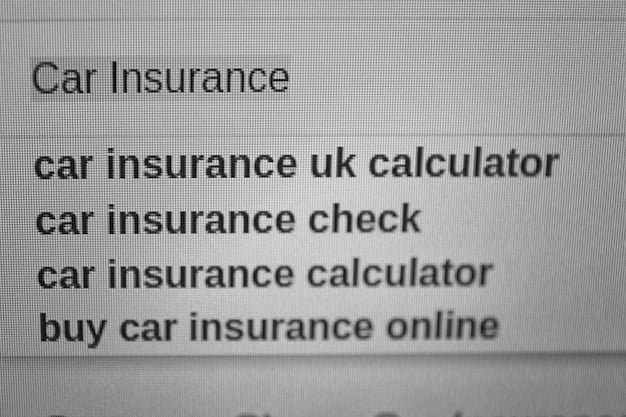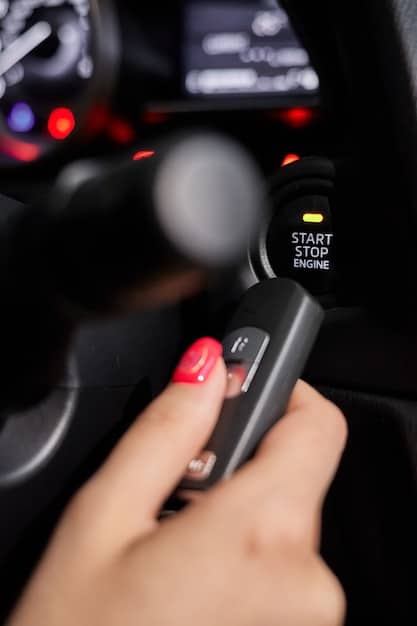Used Car Buying Guide 2025: Avoid Lemons & Hidden Problems

The Used Car Buying Guide 2025 provides a comprehensive overview of how to inspect used vehicles, identify potential issues, and avoid purchasing a lemon, ensuring a reliable and cost-effective car buying experience.
Navigating the used car market can feel like traversing a minefield. This Used Car Buying Guide 2025: Spotting Hidden Problems and Avoiding Lemons will arm you with the knowledge to confidently inspect vehicles, identify red flags, and drive away with a reliable car, not a headache.
The Importance of a Pre-Purchase Inspection
Buying a used car can be a smart financial decision, but it’s crucial to approach it with caution. Skipping a pre-purchase inspection can lead to costly repairs down the road.
Understanding the importance of a thorough inspection is the first step in protecting yourself from mechanical issues and financial setbacks. Don’t rush the process; take your time and be diligent.
Why a Visual Inspection Matters
A visual inspection is your first line of defense. It allows you to identify obvious signs of wear and tear, neglect, or potential problems.
The Role of a Mechanic
While a visual inspection is helpful, a qualified mechanic can provide a more detailed assessment, including checking for hidden problems that may not be visible to the untrained eye.
- Peace of Mind: A pre-purchase inspection offers peace of mind, knowing you’ve done your due diligence.
- Negotiating Power: Identified issues can be used as leverage to negotiate a lower price.
- Avoiding Lemons: Inspections help identify vehicles with significant problems, allowing you to walk away from potential lemons.
By taking the time to perform a pre-purchase inspection, you’re investing in your future and safeguarding your finances. It’s a step that can save you thousands of dollars and countless headaches.
Checking the Vehicle’s History Report
A vehicle history report provides valuable information about a car’s past, including accidents, title issues, and service records. It is an essential tool for making an informed decision.
Obtaining and reviewing a vehicle history report can uncover potential red flags that might not be apparent during a visual inspection.

What to Look for in the Report
Pay close attention to any reported accidents, especially those that resulted in significant damage. Also, check for any title issues, such as salvaged or flood titles.
Popular Vehicle History Report Providers
Several reputable companies offer vehicle history reports, such as Carfax and AutoCheck. Compare their services and choose the one that best fits your needs.
- Accident History: Understanding the severity and frequency of accidents is crucial.
- Title Issues: Avoid vehicles with salvaged, flood, or other problematic titles.
- Service Records: Consistent maintenance records indicate responsible ownership.
A vehicle history report is an invaluable resource that can help you avoid buying a car with a hidden past. Don’t skip this step; it’s well worth the investment.
Examining the Exterior for Damage
A thorough exterior inspection can reveal signs of past accidents, neglect, or potential rust issues. Take your time and pay attention to detail.
Looking closely at the exterior of a used car is a straightforward way to assess its overall condition and identify any potential problems that might require further investigation.
Checking for Rust
Rust is a common problem in older vehicles, especially in regions with harsh winters. Pay close attention to areas prone to rust, such as wheel wells, rocker panels, and undercarriage.
Paint and Body Condition
Examine the paint for inconsistencies, such as mismatched colors or orange peel texture, which could indicate repairs after an accident.
Scratches, dents, and other cosmetic imperfections can also affect the value and appearance of a vehicle. Be sure to factor these into your purchase decision.
The exterior of a car is often the first thing you see, so take the time to scrutinize it carefully. A few minutes of inspection can save you from expensive repairs or regrets later on.
Inspecting the Interior and Electronics
The interior of a used car can provide valuable clues about how well it was cared for. Check for signs of wear and tear, damage, and ensure all electronics are functioning properly.
A well-maintained interior suggests that the previous owner took pride in their vehicle, while a neglected one could indicate potential mechanical issues as well.

Testing the Electronics
Test all electronic components, including the radio, air conditioning, power windows, and seats. Ensure everything is functioning as expected.
Checking for Upholstery Damage
Inspect the seats, carpets, and headliner for stains, tears, or excessive wear. These can be costly to repair or replace.
- Odor Check: Be wary of strong odors like mold or mildew, which could indicate water damage.
- Comfort and Ergonomics: Make sure the seats are comfortable and the controls are easily accessible.
- Functionality: Test all features to ensure they work properly.
A comfortable and functional interior can significantly enhance your driving experience. Don’t overlook this important aspect of your used car purchase.
Evaluating Engine and Mechanical Components
The engine and mechanical components are the heart of any vehicle. A thorough inspection can reveal potential problems that could lead to major repairs.
Listening for unusual noises and checking for leaks can provide valuable insights into the engine’s condition and overall health.
Checking Fluid Levels
Examine the engine oil, coolant, brake fluid, and power steering fluid levels. Low levels or discolored fluids can indicate potential problems.
Listening for Unusual Noises
Start the engine and listen for any unusual noises, such as knocking, ticking, or hissing. These could be signs of mechanical issues.
Pay attention to the engine’s idle speed, which should be steady and smooth. A rough or erratic idle could indicate problems with the fuel system or ignition system.
Taking the time to evaluate the engine and mechanical components can help you avoid buying a car with serious problems. If you’re not comfortable performing this inspection yourself, consider hiring a qualified mechanic.
Road Testing the Vehicle
A road test is an essential part of the used car buying process. It allows you to experience the vehicle’s performance and handling firsthand.
Paying attention to how the car accelerates, brakes, and handles can reveal potential problems that might not be apparent during a static inspection.
Evaluating Handling and Braking
Pay attention to how the car handles in turns and during braking. Uneven braking or excessive body roll could indicate suspension or brake problems.
Checking for Transmission Issues
Listen for smooth and seamless gear changes. Jerky or hesitant shifting could indicate transmission problems.
- Steering Feel: The steering should feel responsive and precise.
- Brake Performance: The brakes should feel firm and stop the car quickly and safely.
- Overall Ride Quality: The ride should be comfortable and smooth, even over bumps and uneven surfaces.
A road test can provide valuable insights into a vehicle’s overall performance and handling. Be sure to take the car for a test drive before making a purchase decision.
| Key Point | Brief Description |
|---|---|
| 🔍 Pre-Purchase Inspection | Crucial for spotting hidden issues before buying. |
| 📜 Vehicle History Report | Reveals accidents, title problems, and service history. |
| 🛠️ Engine Check | Listen for noises, check fluids and overall health. |
| 🚗 Road Test | Evaluate handling, braking, and transmission performance. |
FAQ
▼
A pre-purchase inspection is a comprehensive evaluation of a used car performed by a qualified mechanic to identify any potential problems or issues before you buy it. It can save you from costly repairs later.
▼
A vehicle history report is very important as it provides valuable information regarding a car’s past, including accidents, title issues, and service records. It helps you make a more informed purchase decision.
▼
When inspecting the exterior, look for signs of rust, damage, or previous repairs. Pay close attention to the paint condition and body panels for any inconsistencies or mismatches, indicating possible accidents.
▼
Common signs of a failing transmission include jerky or hesitant shifting, slipping gears, and unusual noises during gear changes. If you notice any of these issues, have the car inspected by a mechanic.
▼
A road test is crucial because it allows you to experience the car’s performance and handling firsthand. It helps you identify potential problems with the engine, transmission, brakes, or suspension that may not be apparent during a static inspection.
Conclusion
By following this **Used Car Buying Guide 2025: Spotting Hidden Problems and Avoiding Lemons**, you can approach the used car market with confidence and make an informed decision. Remember to do your due diligence, inspect the vehicle thoroughly, and don’t hesitate to walk away if something doesn’t feel right. Happy car hunting!





